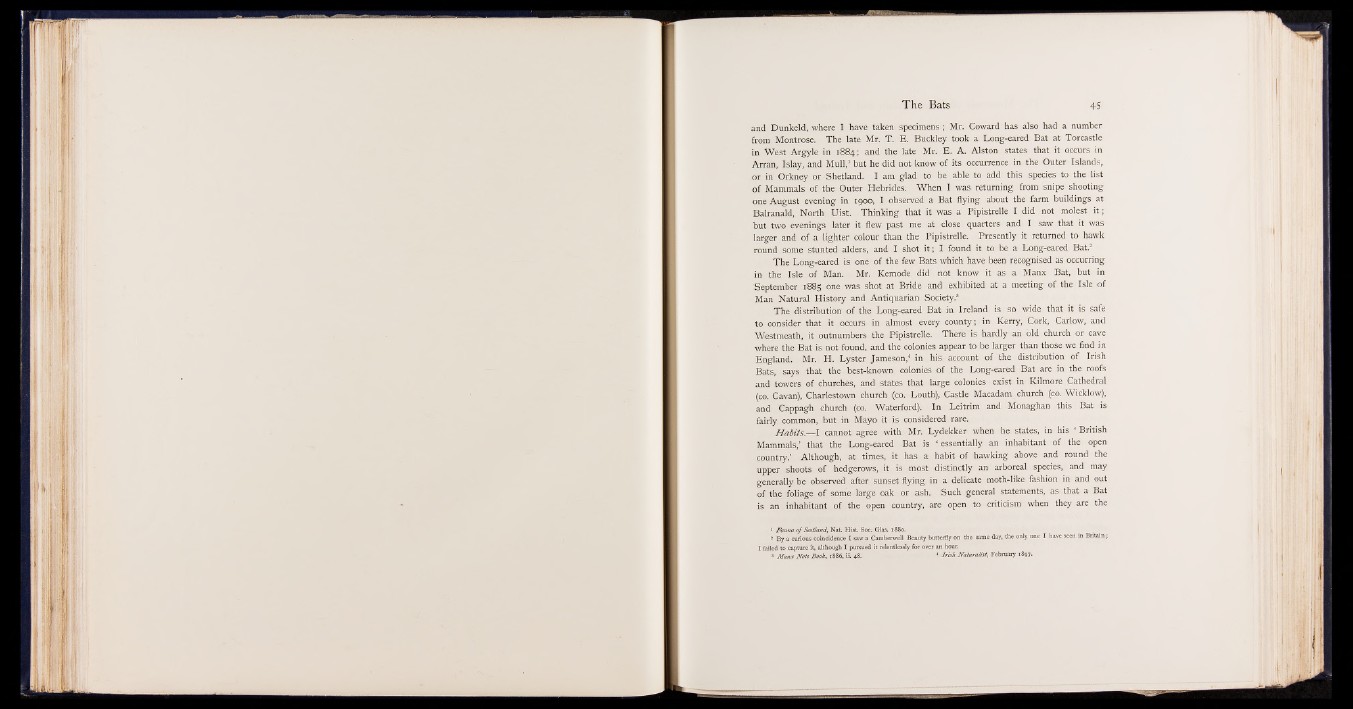
and Dunkeld, where I have taken specimens; Mr. Coward has also had a number
from Montrose. The late Mr. T. B , Buckley took a Long-eared Bat at Torcastle
in West Argyle in 1884; and the late Mr. E. A. Alston, states that it occurs in
Arran, Islay, and MuHj£$ut he did-nqt know of «occurrence in the Outer Islands,
or in Orkney or Shetland, I am gjj^jpstgt. he able to add this species, to the list
of Mammals of the Outer Hebrides. When I was returning from snipe shooting
one August evening in 1900, I observed a Bat flying about the farm buildings at
Balranald, Norths Hist. Thinking that it was a Pipistrelle I. did not molest it;
but two evening^ later it flew past me at . close! quarters and I saw that it was
larger and of a. lighter colour than the Pipistrelle. Presently it returned to hawk
round some stunted aiders,.:a#i I Shot i t ;: I found itofofibe^ Long-eared Bat.!
The Long-eared is omfcjf: tljeefew Bats which haveaboeiurecognised as occurring
in the Isle of Man. Mr. Kcmode did not know it as a Manx Bat, but in
'SeptembeSfi88s one was shot at Bride and exhibited at a meeting of the Isle of
Man Natural History and Antiquarian Society.“
The distribution of the. fi*ng-eared Bat in Ireland., i s i i i l wide, that it is safe
to c o n fe r that it occurs: in almost every county; in Kerry, Cork, Carlow, and
Westmeath, it outnumbers the Pipistrelle.,: There~is hardly an old church or cave
where the Bat ,is not: found, and the colonies appear to be: larger than those we find in
England. Mr. H. Lyster Jameson,4 in his |ac££lunt of the distribution of Irish
Bats., says: that the best-known colonies of the I-ong-eared Hat are in the roofs
and towers of churches, and states that large colonies exist in Kilmore Cathedral
Cavan), Charlestown church (co. Louth): Castle Macadam church ( S Wicklow)}
ando 'Cappagh church Waterford): In Leitrim and Kpnaghan this: Bat »is
fairly comment, but in Mayo it is .jebnsidered rare.
Habits.— I cannot agree with, Mr. Lydekker when he states, in his 1 British
Mammals,’ that the Long-eared Bat is 1 essentially an inhabitant of the open
country.’ Although, at times:, it has a habit of hawking -,ab,ayeS and round the
upper shodts of hedgerows, its.is.-most distinctly an arboreal species, and may
generally be observed after sunset flying in a delicate moth-like fashion in and out
of the foliage of some large oak or ash. Such general statements, :^^that a Bat
its an inhabitant of the open .country, are open to criticism when they are the 1 2 3
1 Fauna o f Scotland, Nat. Hist. Soc.- Glas. 1880.
2 By a curious coincidence I saw a Camberwell Beauty butterfly on the same day, the only one I have seen in Britain;
I failed to capture it, although I pursued it relentlessly for over an hour.
3 Manx Note Book, 1886, ii. 48. 4 Irish Naturalist, February 1897.